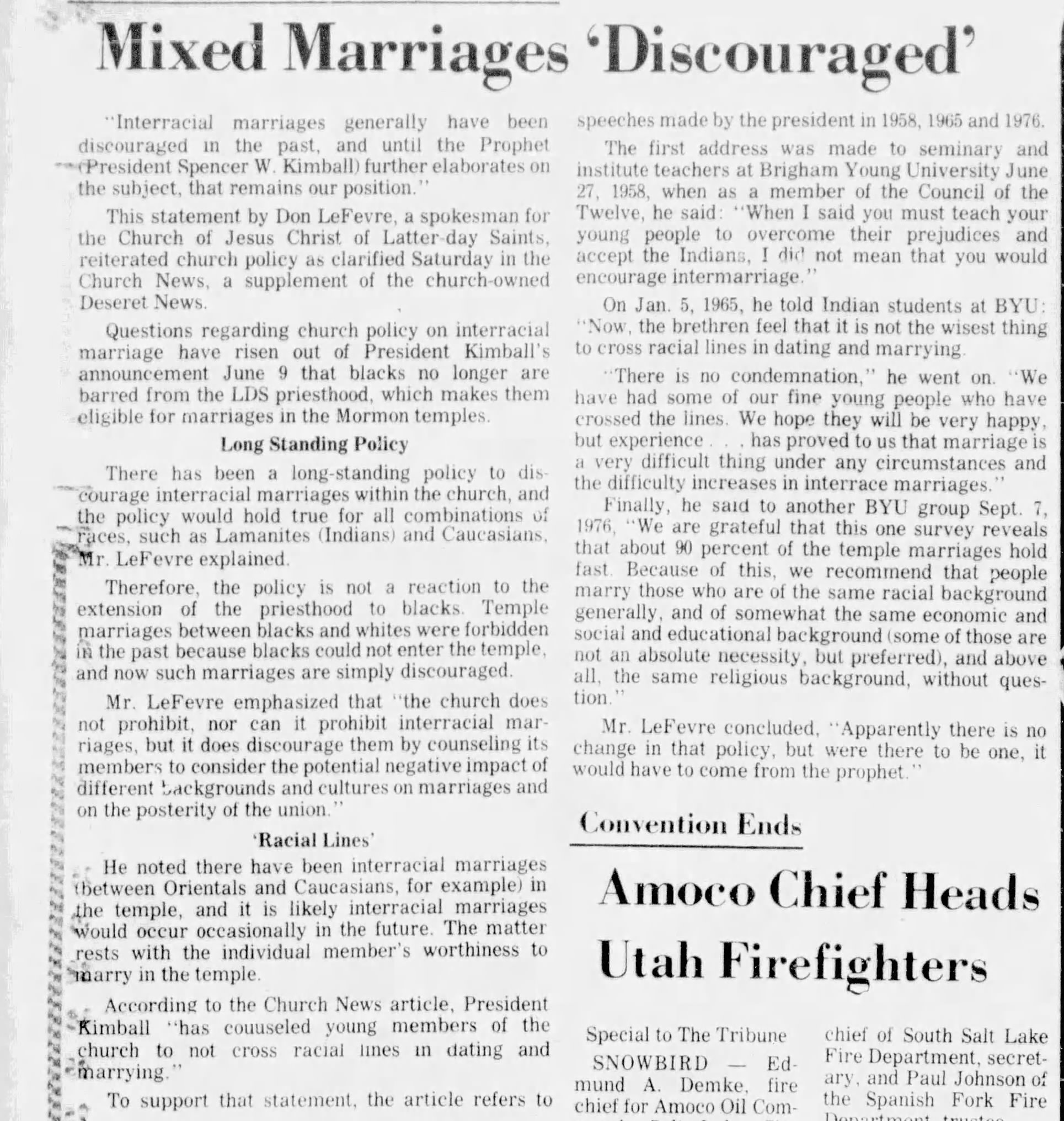Church spokesman Don LeFevre affirms that, despite the reversal of the priesthood and temple ban, mixed marriages are still discouraged.
- Type
- News (traditional)
- Source
- Don LeFevre LDS
- Hearsay
- Journalism
- Reference
"Mixed marriages 'discouraged,'" The Salt Lake Tribune, June 18, 1978, 30, accessed June 28, 2022
- Scribe/Publisher
- The Salt Lake Tribune
- Audience
- General Public
- Transcription
Mixed Marriages 'Discouraged"
"Interracial marriages generally have been discouraged in the past, and until the Prophet (President Spencer W. Kimball) further elaborates on the subject, that remains our position."
This statement by Don LeFevre, a spokesman for the Church of Jesus Christ of Latter-day Saints, reiterated church policy as clarified Saturday in the Church News, a supplement of the church-owned Deseret News.
Questions regarding church policy on interracial marriage have risen out of President Kimball's announcement June 9 that blacks no longer are barred from LDS priesthood, which makes them eligible for marriages in the Mormon temples.
Long Standing Policy
There has been a long standing policy to discourage interracial marriages within the church, and the policy would hold true for all combinations of races, such as Laminates (Indians) and Caucasians, Mr. LeFevre explained.
Therefore, the policy is not a reaction to the extension of the priesthood to blacks. Temple marriages between blacks and whites were forbidden in the past because blacks could not enter the temple and now such marriages are simply discouraged.
Mr. LeFevre emphasized that "the church does not prohibit, nor can it prohibit interracial marriages, but it does discourage them by counseling its members to consider the potential negative impact of different backgrounds and cultures on marriages and on the posterity of the union."
'Racial Lines'
He noted there have been interracial marriages (between Orientals and Caucasians, for example) in the temple, and it is likely interracial marriages would occur occasionally in the future. The matter rests with the individual member's worthiness to marry in the temple.
According to the Church News article, President Kimball "has counseled [sic] young members of the church to not cross racial lines in dating and marrying."
To support that statement, the article refers to speeches made by the president in 1958, 1965 and 1976.
The first address was made to seminary and institute teachers at Brigham Young University June 27, 1958, when as a member of the Council of the Twelve, he said: "When I said you must teach your young people to overcome their prejudices and accept the Indians, I did not mean that you would encourage intermarriage."
On Jan. 5, 1965, he told Indian students at BYU: "Now, the brethren feel that it is not the wisest thing to cross racial lines in dating and marrying.
"There is no condemnation," he went on. "We have had some of our fine young people who have crossed the lines. We hope they will be very happy, but experience . . . has proved to us that marriage is a very difficult thing under any circumstances and the difficulty increases in interface marriages."
Finally, he said to another BYU group Sept. 7, 1976, "We are grateful that this one survey reveals that about 90 percent of the temple marriages hold fast. Because of this we recommend that people marry those who are of the same racial background generally, and of somewhat the same economic and social and educational background (some of those are not an absolute necessity, but preferred), and above all, the same religious background, without question."
Mr. LeFevre concluded, "Apparently, there is not change in that policy, but were there to be one, it would have to come from the prophet."
The B. H. Roberts Foundation is not owned by, operated by, or affiliated with the Church of Jesus Christ of Latter-day Saints.

